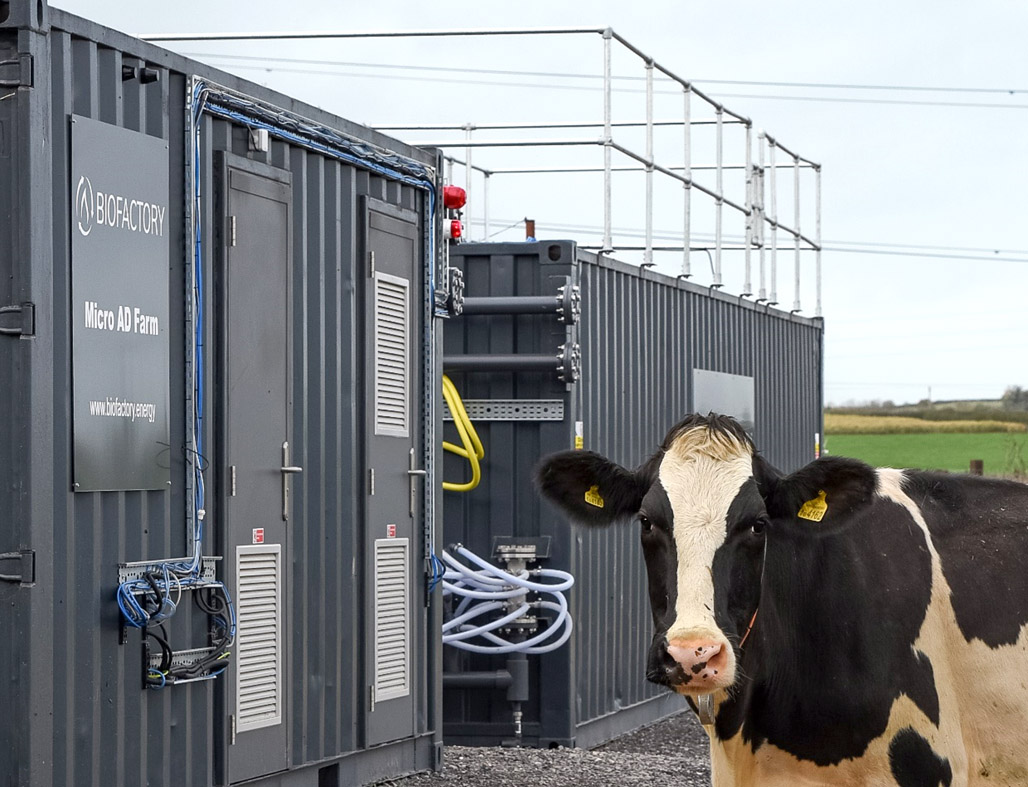At a time of critical debates about the future shape, direction and profitability of the UK farming industry, it’s fair to say that there are huge pressures on farm business owners. Not least of these is the ever-present, and growing, requirement to attain “sustainability”. One technology that is often discussed is on-farm anaerobic digestion (AD) and how to integrate it into farming systems. Lauren Busby reports.
Why is farm AD being championed?
As part of an integrated slurry-management system, farm AD has the potential to maximise the profitability and productivity of farm waste by-products, including organic waste and livestock manures. The process creates a renewable source of energy in the form of biogas, plus a nutrient-rich organic fertilizer called digestate.
The biogas produced by the AD system burns to generate heat and electricity. Farms then use this energy on-site, or sell it off-site for an additional income stream. Thus, this technology can offer farmers security as it reduces the reliance on expensive energy imports from the national grid.
Big AD gobbles resources, but the tech is getting smaller
Until recently, AD has been synonymous with large-scale plants, which carried hefty upfront investment costs. Regular maintenance of this complex asset, plus large feedstock supply costs can mean that this business endeavour often becomes unfeasible.
Some farms with large-scale AD have even transitioned away from traditional farming towards simply growing crops as feedstock for AD plants. This has heightened concerns about food security. After all, shifting land use from food production to energy production through AD reduces the overall land available for growing food.
However, recent developments in AD technology have enabled it to become more adaptable, portable, and affordable. As the technology develops and shrinks, it unlocks the door to new opportunities for small-to-medium sized units to explore the use of AD on their farms.
Here’s a quick demo of a small farm AD system:
AD – things to consider
While the feasibility of smaller scale farm AD is very encouraging, you should consider carefully several important factors before you commit to it.
a) Your feedstock’s quality and quantity
Ultimately, what goes in must come out. The quality of feedstock that goes into a farm AD system will influence the quality of what comes out. Each feedstock has different properties, so it is important to firstly consider the desired output of your digestate, to make the correct selection.
Farm AD experts estimate that the UK produces around 90 million tonnes of manure and slurries per year.
Livestock farms have a golden opportunity to exploit their endless supply of reliable AD feedstock through AD systems. However, despite this advantage, only around 3% of this potential is currently being utilized.
Within Nitrate Vulnerable Zone (NVZ), regulations strictly prohibit the spreading of organic fertiliser within the ‘closed periods’, rendering farmers with no option but to store or export these products. AD offers the potential to capture methane emissions from stored slurry and manure pits, to help stabilise and treat these materials, which enhances the nutrient content when application periods are open again.
By enriching your organic waste, you can reduce your reliance on expensive inorganic fertilizers. This enriched compost allows you to spread nutrients strategically, following nutrient management plans for optimal plant health.
b) Weigh up your long-term strategy
Firstly, what is the end goal for your farm? Start with that in mind: where do you see your business in 5, 10, or even 30 years’ time? Investment in this technology is significant, so consider the life cycle of this technology, funding and payback rates, and your farm succession and transition plans. Doing this will help you assess whether this technology has a place among the goals and objectives of your business.
In short, if you are keen on farm AD, focus hard on its purpose and what it can bring to your business.
For example:
- Is your end goal to operate your in-situ machinery, such as your milking parlour, on renewable energy?
- Do you want to convert biogas into biomethane to be used in your farm machinery?
- Is your objective to reduce on-farm emissions and lower your reliance on costly chemical fertilisers through more efficient management, storage and application of slurry?
Work backwards to ensure that you have the required systems in place from beginning to end, to promote the viability and longevity of a system. Whether it is being able to redistribute heat energy on-farm, or convert biogas into fuel, or maybe to export energy to the grid as an additional income source, there are many opportunities.
However, you should consider them all, and seek advice from multiple sources, not just AD suppliers. For example, speak to local farmers, or farming cluster groups, who have experience of AD systems. Look out for AD-themed farm events too, whether online or in-person.
c) The cost of investment
Cost of investment is a difficult question to answer, often depending on the scale and purpose of the unit you seek. Without a stable Westminster policy on feed-in tariffs, for example, an electricity-generating AD may not be the best option.
As well as the costly installation and materials, you can accrue hidden costs from operational, parts and maintenance. Additionally, you may have to factor in the cost of labour. Furthermore, you may need to factor in potential interest rate hikes if financing with a loan.
A NatWest study in 2020 proposed an easier and more cost-effective method for small-scale operations. This involves simply combusting the gas you produce in your digester for use on your farm. This includes the minor amount of heat produced that is necessary to initiate the digester’s processing of the slurry. NatWest’s study calculated the average cost for a 25kW boiler for a 100-cow farm at around £3,200, plus £300 for a heat exchanger.
Up-front investment and maintenance can be costly. Therefore, it is important to consider the return on investment that can come through offsetting costs and/or exporting. Ask your prospective AD supplier for detailed information. That way, you will be able to work out a cost-benefit analysis that’s specific to your farm and your requirements.
How to proceed with AD
The market for renewable energy has been flooded with lots of farm AD solutions. It is a complicated choice and will depend on factors and conditions that are unique to you and your farm.
That is why it is important for you to take stock of the entire situation. This can be easier said than done, which is why we would recommend that you seek help and guidance. Unlocking the potential for AD may hold the key to a business strategy that promotes long-term sustainability. However, don’t take it on without thorough appraisals.
At Promar, we spend a lot of time getting to know farmers and their businesses. We collaborate carefully, to help you develop strategies that will work for you in the long term.
We have a deep collective experience of farming life, culture, business and pressures. Additionally, we know the local and global agri-business landscapes, as well as the volatility and complications of regulations and funding. Together, this gives us unique perspectives, which we use to help our clients.
We can provide advice via the Farming Resilience Fund too, so we could help you to examine the viability of farm AD for your business free-of-cost. Give us a call on 01270 616800 to start your conversation with one of our consultants, to build sustainability into your farming business.







